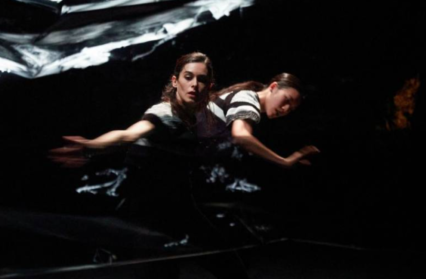Georgia Winstone-Cooper reviews the first installation of National Dance Company Wales’ online Covid-19 lockdown content 2067: Time and Time and Time.

Now that so many artistic spaces have been closed to the public, artists and performers are having to find new platforms on which to express and present their craft. National Dance Company Wales have utilised Zoom for a live performance of 2067: Time and Time and Time and the video production is in few ways inhibited by the format. The style of Zoom allows for the audience to know who is speaking through their own small box being highlighted, but aside from this, there is nothing to focus the viewers’ attention. The result is unnerving and dystopic, the eye is forced to flit between cameras with varied and changing backgrounds; there is no costume nor set and the only link between the dancers is the similar motions and responses to the script and music. The script is at times vague, ambiguous, broad, and it is not always clear what the story is, nor what they are trying to express, and the words being read out in monotone from a phone screen adds a DIY feel to a performance otherwise showcasing the exceptional talent NDCWales has in its ranks.
Rehearsed only the day before filming, the performance is one which would not likely be as effective nor enjoyable if it were viewed through its regular medium, i.e. on a stage, in a crowded theatre. In a theatre, there are few distractions, yet despite this performance being viewed on a small screen in the comfort of the home, it consistently draws focus and never allows the eye, nor mind, to wander. This is a performance of the pandemic era, isolated in its existence online; the piece would be beautiful to be viewed on stage, but it would lose an important dynamic. The cuts to different cameras to reveal skylights and windows in each person’s separate space would be difficult to recreate in a theatre, and if it were somehow achieved it would have a forced and artificial effect. The dancers are performing as they live through a global pandemic and this cannot be ignored through the format; there is beauty in their movements and it is possible to become lost in them, focusing solely on one performer, yet seeing a group of people in their tracksuit bottoms dance in their sitting rooms is a constant reminder as to why this is even happening at all.
It is revealed in the post-show NDCWales Q&A that whilst the performance was choreographed, each dancer had the freedom to alter and add to their movements throughout the piece. Each dance moves in such a unique way that it makes the viewer eager to go back to watch again to ensure nothing was missed from the first time around. The format encourages us to move further and further from the essence of live performance. Rewinding and rewatching are certainly not possible in a theatre and reminds us that whilst we watch the performances alone, the dancers themselves also have no audience. Whilst some are dancing in pairs or groups, there is no applause, no sound other than that of the music and so their movements can be heard. There is no escaping the fact this is disconcerting for the viewer but must be even more so for the dancer; the sound of socks gliding across wooden floors and clothes adjusting to movements brings the attention back, time and again, to thoughts of the pandemic and why this online performance is even happening. Each time a foot thumps to the floor, the viewer is reminded that whilst they may be watching each performance in tandem, the dancers themselves are almost completely alone. It is eerie yet beautiful, connected yet divided, and so is the perfect performances for these strange times.
Learn more about what NDCWales is doing during lockdown from their website.
Georgia Winstone-Cooper is a regular contributor to Wales Arts Review.


 Enjoyed this article? Support our writers directly by buying them a coffee and clicking this link.
Enjoyed this article? Support our writers directly by buying them a coffee and clicking this link.








